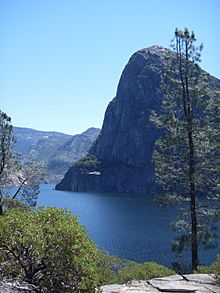Kolana Rock facts for kids
Quick facts for kids Kolana Rock |
|
|---|---|

Kolana Rock as viewed from the North-West side of Hetch Hetchy Valley
|
|
| Highest point | |
| Elevation | 5,774 ft (1,760 m) NAVD 88 |
| Geography | |
| Parent range | Sierra Nevada |
| Geology | |
| Mountain type | Granite dome |
Kolana Rock is a giant, rounded rock formation made of granite. You can find it in Yosemite National Park, right on the southern edge of the beautiful Hetch Hetchy Valley.
This amazing rock stands super tall, about 2,000 feet (610 meters) above the Hetch Hetchy Reservoir. That's like two very tall skyscrapers stacked on top of each other! It sits directly across from another famous rock, Hetch Hetchy Dome. A famous explorer named John Muir said that 'Kolana' was the name Native Americans used for this special rock.
What is Kolana Rock?
Kolana Rock is known as a granite dome. This means it's a huge, smooth, rounded hill or mountain made mostly of granite rock. These domes are formed over millions of years as softer rock wears away, leaving the harder granite behind.
Yosemite National Park is famous for these kinds of rock formations. They are a big part of what makes the park so unique and beautiful. Kolana Rock is a great example of these natural wonders.
Where is Kolana Rock Located?
Kolana Rock is found within the borders of Yosemite National Park in California, U.S.. Specifically, it's in Tuolumne County.
It's a key landmark in the Hetch Hetchy Valley, which is a less crowded but equally stunning part of Yosemite. The rock is part of the larger Sierra Nevada mountain range, which stretches across much of California.
Protecting Wildlife: Peregrine Falcons
For many years, Kolana Rock was closed to rock climbing. This was done to protect a special bird called the Peregrine Falcon. These amazing birds are known for being the fastest animals on Earth!
Peregrine Falcons often build their nests on high, rocky cliffs, like Kolana Rock. The closure helped make sure the falcons could raise their young safely without being disturbed by climbers. This protection was very important for their survival.
The rules about climbing were changed in 2013. This allowed climbers to return to Kolana Rock, but often with special rules to continue protecting the falcons during their breeding season. This shows how parks balance human activities with protecting nature.


